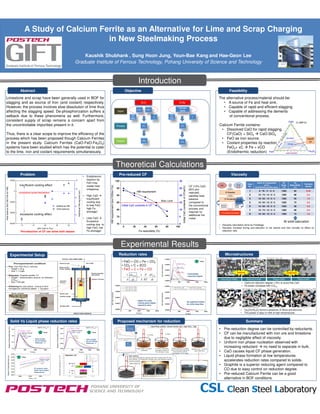Calcium ferrites in BOF_A new steel making process
- 1. A Study of Calcium Ferrite as an Alternative for Lime and Scrap Charging in New Steelmaking Process Kaushik Shubhank , Sung Hoon Jung, Youn-Bae Kang and Hae-Geon Lee Graduate Institute of Ferrous Technology, Pohang University of Science and Technology Introduction Limestone and scrap have been generally used in BOF for slagging and as source of Iron (and coolant) respectively. However, the process involves slow dissolution of lime thus affecting the slagging speed. De-phosphorization suffers a setback due to these phenomena as well. Furthermore, consistent supply of scrap remains a concern apart from the uncontrollable impurities present in it. Thus, there is a clear scope to improve the efficiency of the process which has been proposed though Calcium Ferrites in the present study. Calcium Ferrites (CaO-FeO-Fe2O3) systems have been studied which has the potential to cater to the lime, iron and coolant requirements simultaneously. The alternative process/material should be: ŌĆó A source of Fe and heat sink. ŌĆó Capable of rapid and efficient slagging. ŌĆó Capable of addressing the demerits of conventional process. Calcium Ferrite contains: ŌĆó Dissolved CaO for rapid slagging. CF(CaO) + SiO2 CaO.SiO2 ŌĆó FeO as iron source. ŌĆó Coolant properties by reaction FeOx+ xC Fe + xCO (Endothermic reduction) Abstract Objective Feasibility Liquid CF Theoretical Calculations Problem 10 15 20 25 30 -60000 -40000 -20000 0 20000 Heat balance Heatbalance(MJ)(MJ/100tonHM) wt% CaO in Flux excessive cooling effect insufficient cooling effect 0 3 6 9 12 15 Additional HM AdditionalHMrequired(ton) ŌĆó Endothermic reaction by FeO may create heat imbalance. ŌĆó High CaO Insufficient cooling due to less FeO, high Fe shortage! ŌĆó Less CaO Excessive cooling due to high FeO, low Fe shortage!Pre-reduction of CF can solve both issues! Pre-reduced CF CF (13% CaO, 60% pre- reduced) satisfies heat balance compared to the conventional process and requires no additional hot metal. Case No. Initial CF composition (wt%) CaO/FeO/Fe2O3/SiO2/Al2O3 CF Temp. (┬░C) Fe Reducibility (%) Viscosity (poise) 1 8 / 76 / 11 / 5 / 0 1300 65 0.35 2 10 / 74 / 12 / 0 / 4 1300 88 2.4 4 19 / 63 / 14 / 0 / 4 1300 65 1.6 5 16 / 64 / 15 / 0 / 5 1200 72 3.2 6 19 / 60 / 16 / 0 / 5 1200 58 2.6 7 10 / 74 / 12 / 2 / 2 1300 90 2.4 9 18 / 65 / 13 / 2 / 2 1300 72 1.6 Viscosity At solid saturation ŌĆó Viscosity calculation done by FactSage ŌĆó Viscosity increase during pre-reduction is not severe and has virtually no effect on reduction rate. Experimental Results ŌĆó FeO + CO = Fe + CO2 ŌĆó CO2 + C = 2CO ŌĆó FeO + C = Fe + CO Reduction rates Controllable reduction degree Higher Fe oxide content gives higher reduction rates No significant effect by oxide impurities Experimental Setup Microstructures Fe(s)+C2F+FeOx Fe(s)+C2F+CaO Fe(s)+CaO Fe(s)+CaO ŌĆó Optimum reduction degree <70% to avoid free CaO ŌĆó Fe phase increases with C/Ceq ŌĆó Ca2(Fe,Al)2O5 forms in presence of Silica and Alumina. ŌĆó This phase is easy to melt at high temperatures. Desired Undesired Solid Vs Liquid phase reduction rates ŌĆó Solid powder ŌĆó No pre-melting ŌĆó Reductant: C ŌĆó Solid powder ŌĆó No pre-melting ŌĆó Reductant: C CF systems show faster rate at higher temperatures! Reductant: CO Proposed mechanism for reduction Summary Good GoodGood Good ŌĆó Pre-reduction degree can be controlled by reductants. ŌĆó CF can be manufactured with iron ore and limestone due to negligible effect of viscosity. ŌĆó Uniform iron phase nucleation observed with increasing reductant no need to separate in bulk. ŌĆó CaO causes liquid CF phase generation. ŌĆó Liquid phase formation at low temperatures accelerates reduction rates compared to solids. ŌĆó Graphite is a superior reducing agent compared to CO due to easy control on reduction degree. ŌĆó Pre-reduced Calcium Ferrite can be a good alternative in BOF conditions. Base Level Conventional system heat balance

